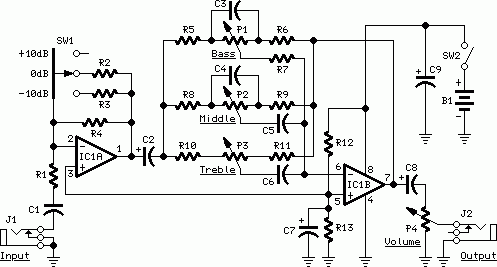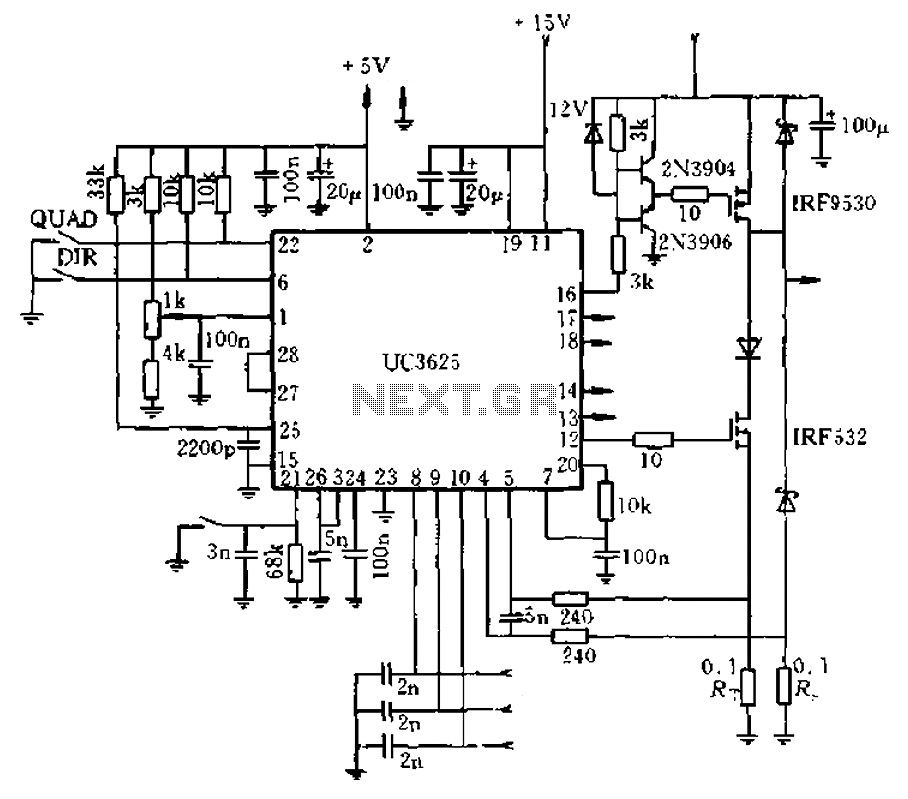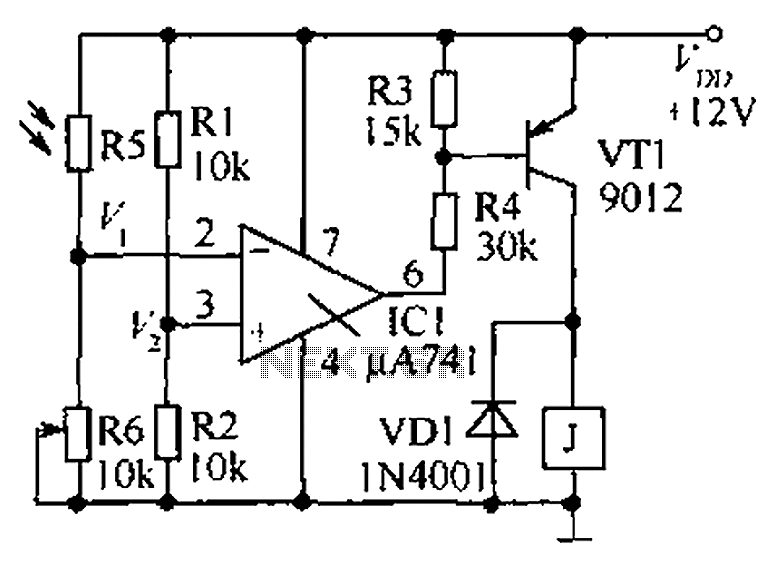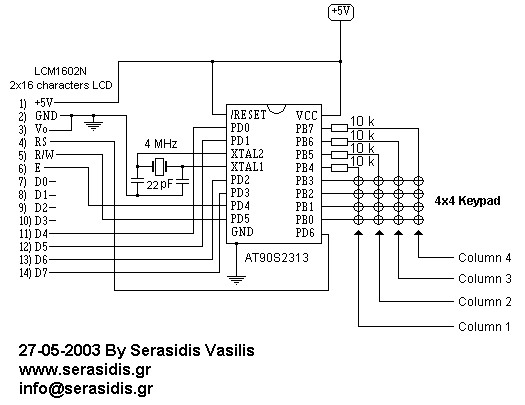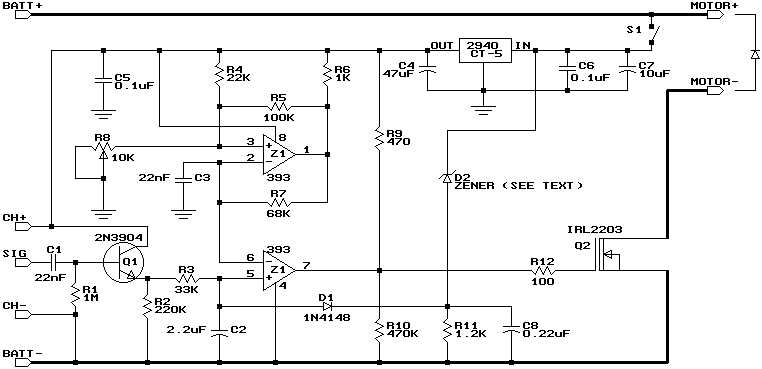
Alarm Control Electronic Keypad Project
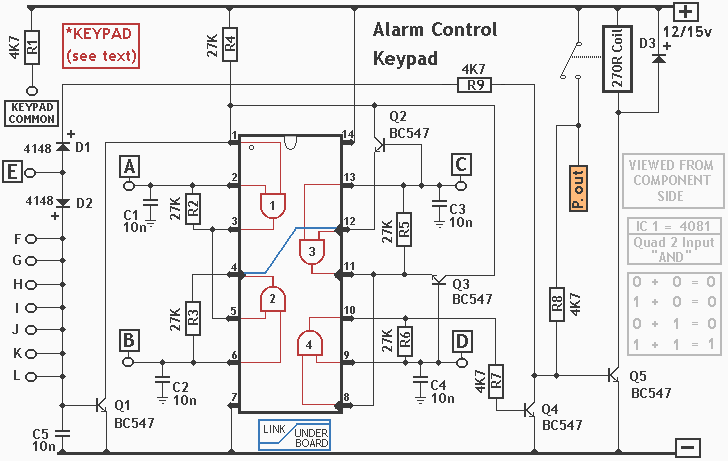
The integrated circuit (IC) is a quad 2-input "AND" gate, specifically a CMOS 4081. These gates output a HIGH signal only when both inputs are HIGH. When the key connected to pin E is pressed, current flows through resistor R1 and diode D1, activating transistor Q5. This energizes the relay, and Q5 is kept in the "on" state by resistor R8. Consequently, the alarm is activated by pressing a single key, such as one of the two non-numeric symbols. The alarm will deactivate when the four keys connected to pins A, B, C, and D are pressed in the correct sequence. The circuit functions because each gate relies on its predecessor. If any incorrect key is pressed, gate 1 is disrupted, resulting in a failed code entry. Pin 1 is held HIGH by resistor R4, which enables gate 1. When button A is pressed, the output at pin 3 goes HIGH, performing two functions: it locks itself ON through R2 and enables gate 2 by bringing pin 5 HIGH. If B is pressed next, the output of gate 2 at pin 4 also goes HIGH, locking itself ON via R3 and enabling gate 3 by raising pin 12 HIGH. When C is pressed, gate 3 locks itself ON through R5 and enables gate 4 by bringing pin 8 HIGH. Pressing D causes gate 4 to perform similarly, with its output at pin 10 turning transistor Q4 ON. This action grounds the base of Q5, turning it OFF and allowing the relay to deactivate, thus silencing the alarm. Any keys not connected to A, B, C, D, or E are wired to the base of transistor Q1. If E or any of these other keys are pressed, pin 1 is taken LOW, resetting the circuit. Additionally, if C or D is pressed out of sequence, transistors Q2 or Q3 will also pull pin 1 LOW, resetting the circuit. Therefore, no action occurs until A is pressed, and if any key other than B is pressed thereafter, the circuit resets. The keypad must be of the type with a common terminal and individual connections for each key. A 12-key keypad should have 13 terminals; the matrix type with 7 terminals is not suitable. Connect the common terminal to R1 and assign the chosen code to A, B, C, and D. Connect E to the key designated for activating the alarm, while the remaining keys connect to the base of Q1. The provided diagram serves as a general layout guide for component placement if using a strip board. The code may include non-numeric symbols, and a numeric keypad is not mandatory; a custom keypad can be created. The total number of possible code combinations exceeds 10,000 with a 12-key keypad, posing a challenge for potential intruders who are unaware of the circuit's limitations. For enhanced security, an additional 4081 can be integrated to continue enabling subsequent gates, or a larger keypad with more "WRONG" keys can be utilized. Any small audio transistors are suitable for this application. The 27k resistors can be substituted with values up to 100k, while the 4.7k resistors are necessary to protect the junctions and provide sufficient current to fully activate the transistors.
The circuit utilizes a CMOS 4081 quad 2-input AND gate configuration to create a secure alarm system. Each input key is strategically assigned to specific gates, enabling a sequential activation process that ensures only the correct combination deactivates the alarm. The design leverages the properties of the AND gate, where the output is HIGH only when all inputs are HIGH, effectively creating a layered security mechanism.
The alarm system's operation begins with pressing the key connected to pin E, which initiates the circuit by allowing current to flow through R1 and D1, activating Q5. The relay is energized, and the alarm is set in motion. The inclusion of resistors R2, R3, R5, and R8 ensures that each gate remains enabled until the correct sequence of keys is entered. If at any point an incorrect key is pressed, the system resets, preventing unauthorized access.
The circuit is designed with flexibility in mind, allowing for a variety of keypads, including custom designs. The requirement for a common terminal simplifies the wiring process, ensuring that the alarm system can be easily implemented. The potential for over 10,000 unique combinations significantly enhances security, making it difficult for an intruder to guess the correct sequence.
For added security, the architecture can be expanded by integrating additional 4081 ICs to create more complex combinations or by utilizing larger keypads with additional incorrect key options. This adaptability makes the circuit suitable for various applications, from home security systems to more specialized uses. The careful selection of components, including transistors and resistors, ensures reliable operation while maintaining a straightforward design that can be easily replicated or modified.The IC is a quad 2 input "AND" gate, a CMOS 4081. These gates only produce a HIGH output, when BOTH the inputs are HIGH. When the key wired to `E` is pressed, current through R1 and D1 switches Q5 on. The relay energizes; and Q5 is `latched on` by R8. Thus, the Alarm is set by pressing a single key, say one of the two non-numeric symbols. The alar m will switch off when the 4 keys connected to "A, B, C, D" are pushed in the right order. The circuit works because each gate `Stands` upon its predecessor. If any key other than the correct key is pushed, then gate 1 is knocked out of the stack, and the code entry fails. Pin 1 is held high by R4. This `Enables` gate 1; and when button `A` is pressed, the output at pin 3 will go high. This output does two jobs. It locks itself `ON` through R2 and it `Enables` gate 2, by taking pin 5, high. Now, if `B` is pressed, the output of gate 2, at pin 4 will go high. This output does two jobs. It locks itself `ON` through R3 and it `Enables` gate 3 by taking pin 12 high. Now, if `C` is pressed, the output of gate 3 will lock itself `ON` through R5 and, by taking pin 8 high, `Enable` gate 4.
Pressing `D` causes gate 4 to do the same thing; only this time its output, at pin 10, turns Q4 `ON`. This takes the base of Q5 to ground, switching it off and letting the relay drop out. This switches the alarm off. Any keys not connected to `A B C D E` are wired to the base of Q1. Whenever `E` or one of these other keys is pressed, pin 1 is taken low and the circuit is reset. In addition, if `C` or `D` is pressed out of sequence, then Q2 or Q3 will take pin 1 low and the circuit will reset.
Thus nothing happens until `A` is pressed. Then if any key other than `B` is pressed, the circuit will reset. The Keypad needs to be the kind with a common terminal and a separate connection to each key. On a 12 key pad, look for 13 terminals. The matrix type with 7 terminals will NOT do. Wire the common to R1 and your chosen code to `A B C D`. Wire `E` to the key you want to use to switch the alarm on. All the rest go to the base of Q1. The diagram should give you a rough guide to the layout of the components, if you are using a strip board. The code you choose can include the non-numeric symbols. In fact, you do not have to use a numeric keypad at all, or you could make your own keypad. I haven`t calculated the number of combinations of codes available, but it should be in excess of 10 000 with a 12 key pad; and, after all, any potential intruder will be ignorant of the circuit`s limitations.
Of Course, if you must have a more secure code, I can think of no reason why you shouldn`t add another 4081 and continue the process of enabling subsequent gates. Or you could simply use a bigger keypad with more "WRONG" keys. Any small audio transistors should do. The 27k resistors could be replaced with values up to 100k. And the only requirements for the 4k7 resistors is that they protect the junctions while providing enough current to turn the transistors fully on.
🔗 External reference
The circuit utilizes a CMOS 4081 quad 2-input AND gate configuration to create a secure alarm system. Each input key is strategically assigned to specific gates, enabling a sequential activation process that ensures only the correct combination deactivates the alarm. The design leverages the properties of the AND gate, where the output is HIGH only when all inputs are HIGH, effectively creating a layered security mechanism.
The alarm system's operation begins with pressing the key connected to pin E, which initiates the circuit by allowing current to flow through R1 and D1, activating Q5. The relay is energized, and the alarm is set in motion. The inclusion of resistors R2, R3, R5, and R8 ensures that each gate remains enabled until the correct sequence of keys is entered. If at any point an incorrect key is pressed, the system resets, preventing unauthorized access.
The circuit is designed with flexibility in mind, allowing for a variety of keypads, including custom designs. The requirement for a common terminal simplifies the wiring process, ensuring that the alarm system can be easily implemented. The potential for over 10,000 unique combinations significantly enhances security, making it difficult for an intruder to guess the correct sequence.
For added security, the architecture can be expanded by integrating additional 4081 ICs to create more complex combinations or by utilizing larger keypads with additional incorrect key options. This adaptability makes the circuit suitable for various applications, from home security systems to more specialized uses. The careful selection of components, including transistors and resistors, ensures reliable operation while maintaining a straightforward design that can be easily replicated or modified.The IC is a quad 2 input "AND" gate, a CMOS 4081. These gates only produce a HIGH output, when BOTH the inputs are HIGH. When the key wired to `E` is pressed, current through R1 and D1 switches Q5 on. The relay energizes; and Q5 is `latched on` by R8. Thus, the Alarm is set by pressing a single key, say one of the two non-numeric symbols. The alar m will switch off when the 4 keys connected to "A, B, C, D" are pushed in the right order. The circuit works because each gate `Stands` upon its predecessor. If any key other than the correct key is pushed, then gate 1 is knocked out of the stack, and the code entry fails. Pin 1 is held high by R4. This `Enables` gate 1; and when button `A` is pressed, the output at pin 3 will go high. This output does two jobs. It locks itself `ON` through R2 and it `Enables` gate 2, by taking pin 5, high. Now, if `B` is pressed, the output of gate 2, at pin 4 will go high. This output does two jobs. It locks itself `ON` through R3 and it `Enables` gate 3 by taking pin 12 high. Now, if `C` is pressed, the output of gate 3 will lock itself `ON` through R5 and, by taking pin 8 high, `Enable` gate 4.
Pressing `D` causes gate 4 to do the same thing; only this time its output, at pin 10, turns Q4 `ON`. This takes the base of Q5 to ground, switching it off and letting the relay drop out. This switches the alarm off. Any keys not connected to `A B C D E` are wired to the base of Q1. Whenever `E` or one of these other keys is pressed, pin 1 is taken low and the circuit is reset. In addition, if `C` or `D` is pressed out of sequence, then Q2 or Q3 will take pin 1 low and the circuit will reset.
Thus nothing happens until `A` is pressed. Then if any key other than `B` is pressed, the circuit will reset. The Keypad needs to be the kind with a common terminal and a separate connection to each key. On a 12 key pad, look for 13 terminals. The matrix type with 7 terminals will NOT do. Wire the common to R1 and your chosen code to `A B C D`. Wire `E` to the key you want to use to switch the alarm on. All the rest go to the base of Q1. The diagram should give you a rough guide to the layout of the components, if you are using a strip board. The code you choose can include the non-numeric symbols. In fact, you do not have to use a numeric keypad at all, or you could make your own keypad. I haven`t calculated the number of combinations of codes available, but it should be in excess of 10 000 with a 12 key pad; and, after all, any potential intruder will be ignorant of the circuit`s limitations.
Of Course, if you must have a more secure code, I can think of no reason why you shouldn`t add another 4081 and continue the process of enabling subsequent gates. Or you could simply use a bigger keypad with more "WRONG" keys. Any small audio transistors should do. The 27k resistors could be replaced with values up to 100k. And the only requirements for the 4k7 resistors is that they protect the junctions while providing enough current to turn the transistors fully on.
🔗 External reference
